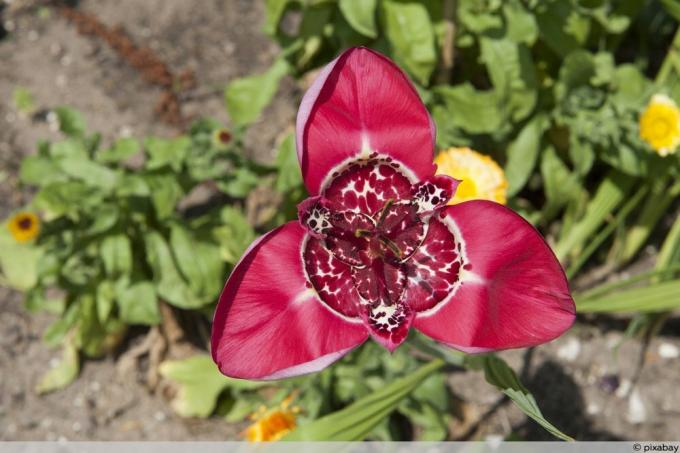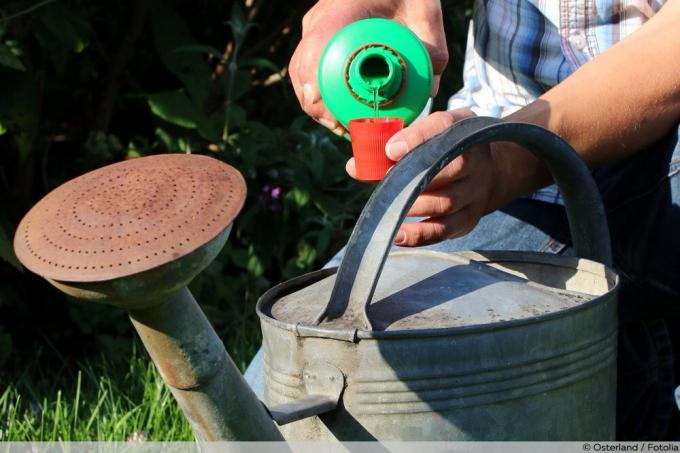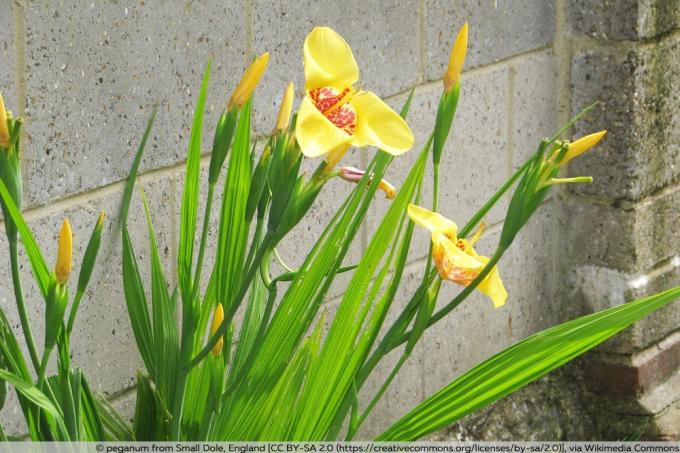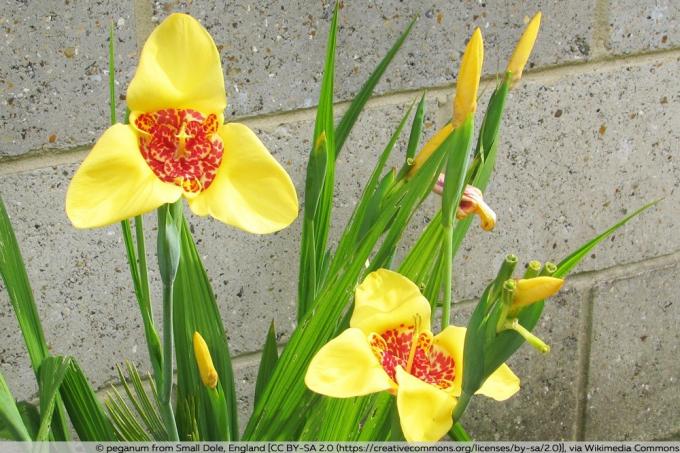
table of contents
- Characteristics
- Likelihood of confusion
- Location
- Soil and substrate
- care
- to water
- Fertilize
- Cut
- Repot
- Overwinter
- Multiply
- Diseases and pests
Profile and care information open +conclude -
- Flower color
- yellow, red, purple, white
- Location
- Sunny, full sun
- Heyday
- July August
- Growth habit
- upright
- height
- up to 60 cm high
- Soil type
- sandy, loamy
- Soil moisture
- moderately moist, very moist, fresh
- PH value
- neutral, slightly acidic
- Limescale tolerance
- k. A.
- humus
- rich in humus
- Plant families
- Iris family, Iridaceae
- Plant species
- Bulbous flowers, summer flowering plants, ornamental plants
- Garden style
- Flower garden, ornamental garden
Tiger flowers, botanically Tigridia, are a genus of plants from the iris family. Of the 45 to 59 species of tiger flowers, the varieties of the real tiger flower (Tigridia pavonia) are used as ornamental plants. The plants form large flowers in the summer months, but they only bloom for a few hours. But don't worry, the tiger flower ensures a constant supply of flowers, so that it blooms continuously for several weeks.
Characteristics
- botanical name: Tigridia
- Plant family: Iris family (Iridaceae)
- Synonyms: peacock flower, tiger lily, peacock lily
- Growth: upright, 30 to 60 centimeters
- Flower: spotted center of the flower
- Flower color: white, yellow, red and purple (depending on the variety)
- Flowering period: July to August
- Varieties: "Alba", "Aurea", "Canariensis", "Lilacea", "Speciosa"
Likelihood of confusion
The term "peacock flower" can easily lead to confusion, because it is not only used by Tigridia pavonia. It is also used for the peacock bush (Caesalpinia) and the blue peacock flowers (Dies iridioides).
Location

The tiger flower is not hardy. The onion flower can, however, spend the summer outdoors either planted in the garden bed or in the container culture on the balcony or terrace. The summer bloomers love the sun, but they don't like wind. Therefore, the optimal location for the ornamental plants is:
- sunny or full sun
- sheltered from the wind
Tip: In the tub culture, you should also choose a location protected from rain for the tiger flower, as the plants cannot tolerate waterlogging.
Soil and substrate
In the garden bed, Tigerblume wants a soil that has the following properties:
- relaxed
- sandy-loamy
- humus
- fresh-moist
- pH: 6.0 to 7.0
The following mixture has proven itself in bucket culture:
- 2 parts of potted plant soil
- 1 part sand
- 1 part clay granules or pumice gravel
Neighboring planting
Tiger flowers are ideal for an onion flower bed. The following are therefore suitable as neighboring plants:
- Gladiolus
- Lilies
- Irises
- Summer hyacinths
- Tulips
Planting out and outdoor season

The peacock flower does not tolerate temperatures below 10 degrees Celsius outdoors. Therefore, the planting date in this country falls more in June than in May.
Plant onions
Before the bulbs go into the garden bed, you should prepare the soil as follows:
- loosen up thoroughly
- Remove weeds and / or larger stones
- Chop coarse chunks of earth into fine crumbs
- Ground if necessary. with humus, sand, clay granulate or Optimize pumice gravel
- Attach a gravel drainage to prevent waterlogging at a depth of 5 to 10 centimeters
- Once the soil has been prepared, you can put the onions in the bed:
- Planting depth: two to three times as deep as the height of the bulb
- Plant spacing: at least 12 to 15 centimeters
- Pour sparingly
Tip: The watering is only increased when the plant sprouts visibly.
In the potted culture, the depth and spacing of the planting correspond to those for the garden bed. The open-air season on the balcony or terrace also begins with this form of cultivation after the last late frosts, when the temperatures are constantly around ten degrees Celsius.
care
Whether tiger flowers are easy or moderately difficult to care for is controversial. The most common care mistake definitely concerns watering. Because waterlogging, and the associated rotting of the onion, is the greatest enemy of the peacock flower. You should therefore keep the plants slightly moist, but make sure not to give them too much water. In the bucket culture, it is best to put a drainage layer on the bottom of the pot and always remove the water from the saucer. This way the tiger flower doesn't get wet feet.
to water
Tiger flowers that are planted in the bed always need slightly moist soil until autumn. However, you should not give the plants too much water, even if it is well meant, because tiger flowers do not tolerate waterlogging. This also applies to the bucket culture, but here the peacock flower often requires watering because the substrate in the pot dries out faster.
Tip: If you have watered the peacock too much, its leaves will wither. In this case, you should stop watering immediately.
Fertilize

Tiger flowers that are planted every year in freshly optimized garden soil in the open do not need any additional fertilizer. In the bucket culture, if the plants have not been repotted in fresh substrate, they are fertilized every four weeks from April to September with a conventional liquid fertilizer. Alternatively, a long-term fertilizer in the form of granules or sticks can be used for potted plants. The long-term fertilizer is fertilized once in spring.
Cut
The tiger flower does not need a special cut. However, to avoid self-sowing, you should regularly cut off the flower stalks of withered flowers.
Repot
In bucket culture, it is advisable to repot the tiger flower every two to three years, i.e. to provide it with fresh substrate. The ideal time for this is in the spring after wintering. Since potted plant soil is usually provided with a slow-release fertilizer, you do not need to fertilize the plants any further in the year they are repotted.
Overwinter

As with all other onion flowers, not the entire plant overwinters, only the bulbs. The open-air season ends when the first (night) frosts threaten. For a successful wintering it is important that the above-ground parts of the plant remain on the plant as long as possible. Because the onion draws nutrients from them until the end, which it needs for the winter.
Tip: In preparation for wintering, reduce the amount of water you need to water after the last flowers have wilted.
Hibernate planted tiger flowers
The move of the onions to the winter quarters begins with the careful digging up of the onions. Then cut off the above-ground parts of the plant. Then proceed as follows:
- Let the onions dry on newspaper in a dark place (out of direct sunlight)
- Remove loosely adhering earth
- Leave stubborn soil on the onion
- Do not remove brood or daughter onions
- "Wrap" onions in wood wool
Alternatively, you can overwinter the dug out onions in a pot with soil or sand. In this case, however, they need to be supplied very sparingly with water about every four weeks so that they do not dry out. This procedure is particularly recommended for bucket culture, as the onions do not have to be dug up.
Winter quarters
The winter quarters have the following properties in both cases:
- Frost free
- cool and airy (no drafts)
- Temperature: not below 7 degrees Celsius
- ideal temperature: 8 to 10 degrees
- dark
The onions are only returned to the field when frosts are no longer to be expected. Alternatively, you can prefer onions intended for the garden bed as potted plants. To do this, put them in a pot, as for tiger flowers as balcony plants, and place them on a light window sill. So that the plants get used to the outside temperatures, you should allow them a period of acclimatization after the last late frosts in May.
Multiply

Propagate with daughter onions
Brood or daughter onions are created naturally. For propagation they have to be separated from the mother onion. The ideal time for this is after overwintering, because then they can be planted out immediately or put in a pot for planting in a bucket. When removing and inserting, keep the following in mind:
- Carefully separate the daughter and mother onions
- Do not damage roots and bulbs
- Use with caution
- pour on
If young tiger flowers are to be preferred from the bulbs, they should be put in a pot with soil as early as April. Then place them in a bright location out of direct sunlight.
Tip: You should only expect the first flowers after two to three years.
Propagate with seeds
For propagation with seeds, you should obtain them from older plants. For younger plants that are blooming for the first time, you should even avoid seed formation, as this will weaken the plants very much. For this form of propagation, proceed as follows:
- Seeds at the end of February or sow in March
- Place 10 to 12 seeds in a 13 centimeter diameter pot
- cover lightly with soil
- carefully pour on or spray
- place on a light window sill
- keep slightly moist
When the first seedlings appear, they are placed in individual pots (prick out). If stately young plants have formed, they can be planted out in the garden after the last frosts. With this form of reproduction, the first flowers can be expected after one to one and a half years.
Diseases and pests
Diseases, such as root rot, are often based on poor care. If the putrefaction has progressed, the plants can no longer be saved. So far nothing is known about the infestation of pests. Only snails are a danger to the tiger flower, as they like to eat the peacock flower.



